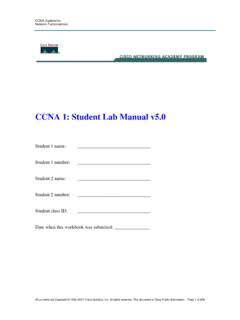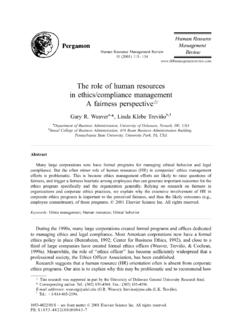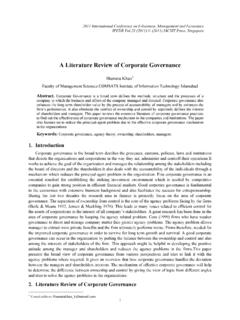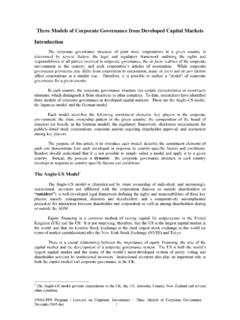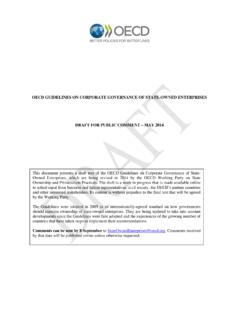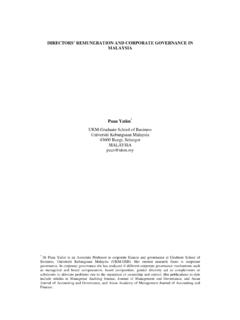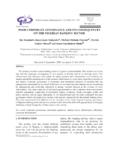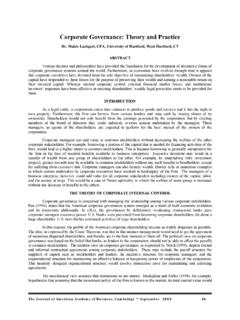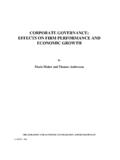Transcription of Shareholder Wealth Maximization
1 CHAPTER 23 Shareholder WealthMaximizationDUANE WINDSORL ynette S. Autrey Professor of Management, Jesse H. Jones Graduate School ofBusiness, Rice UniversityINTRODUCTIONThe Shareholder Wealth Maximization (SWM) principle states that the immediateoperating goal and the ultimate purpose of a public corporation is and shouldbe to maximize return on equity capital. The SWM specification of what is oftentermed thecorporate objectivemakes operating goal and ultimate purpose the same:Managers and investors should focus narrowly on question of whether the corporate objective can be a strict emphasis onSWM or must recognize significant differences between the operating goal for man-agers and investors and the ultimate social purpose of the public corporation liesat the intersection of three literatures. In economics and finance literature, SWM isa standard assumption. This SWM operating goal is expected to yield the most so-cially efficient allocation of capital.
2 Business ethics, corporate social responsibility,and stakeholder theory literature emphasizes significant differences between anoperating goal of SWM and the ultimate social purpose of the public law addresses duties, responsibilities, and rights of both financial andnonfinancial stakeholders. In the United States, the business judgment rule andin various states corporate constituency statutes permit relaxation in SWM as anoperating goal in favor of stakeholder and social chapter addresses ethical considerations concerningthe SWM principleand its managerial implications. A key factor in understanding SWM is that thepublic corporation is simultaneously private property, a web or nexus of contracts,a governmentally licensed and traded securities registrant, a social benefits entity,and a locus of stakeholder introduction explains some basic points of general relevance. The secondsection discusses the historical background of SWM and sometechnical consider-ations including measurement issues.
3 The third section explains justifications forSWM. The fourth, fifth, and sixth sections explicate three critiques of SWM arisingfrom (1) business ethics and corporation law, (2) corporatesocial responsibility(CSR), and (3) stakeholder theory. The chapter concludes with a summary of thearguments for and against SWM and their implications for ManagementShareholder Wealth Maximization focuses on the motives andbehaviors offinancial stakeholders. The thesis of separation of ownership and control (Berleand Means 1932) posits that principals (or shareowners) employ agents (or man-agement) who must have some reasonable discretion ( , the business judgmentrule). At law, officers and directors have a fiduciary duty to safeguard the financialinterests of the shareholders (or shareowners). The SWM principle can be stated,however, in two stronger form argues that, within any set of legal and ethical constraints,the corporate objective is and should be strictly SWM.
4 The operating goal andultimate purpose of the public corporation are the same. Fiduciary duty oughttherefore to be tightly focused on SWM. From this viewpoint,CSR activity is inap-propriate Wealth -decreasing altruism unless it yields future positive returns to thefirm. This strong form associates with the views that legal and ethical constraintson corporate activity ought to be minimal and that institutions (including commonlaw and social norms) should be market-facilitating. A multinational corporationmay be able to select sets of legal and ethical constraints, varying by country, withinwhich it will may be a significant difference between management s operating goaland the ultimate social purpose of the public corporation. Aweaker form thereforerelaxes the strict formulation to a more nuanced argument that the corporateobjective is and should be primarily SWM. A relaxation admits, beyond legal andethical constraints, consideration of CSR and interests ofnonfinancial relaxation understands that managerial responsibility is more complicatedthan mere fiduciary duty.
5 The relaxation accepts that legal and ethical constraintsare and ought to be stronger than minimalist (Windsor 2008).One must decide which view to accept. One way to combine strong and weakforms is to argue that shareowners can and do make pragmatic choices that bestprotect their financial interest. A combined approach retains the financial goal andmarket context of the strong form but expects shareowners tofigure out how best toaddress agents, nonfinancial stakeholders, and gatekeepers (Boatright 2007). Theshareowners may decide to act in accord with the weak form in order to advancethe SWM goal posited in the strong chapter explains three key objections to a strong SWM formulation ofthe corporate objective. These objections are logically admitted by any nuancedstatement of SWM as a primary rather than as a singular goal for previously explained, a goal and a purpose need not be the same. The nar-row (but socially penultimate) goal of investors is to maximize financial broader (and ultimate) purpose of a public corporation,a rationale for gov-ernment licensing, is generation of social benefits.
6 Both corporate social perfor-mance (CSP) and financial performance should be positive. The three objectionsare as follows. First, business ethics functions as a set of supralegal constraintson managerial conduct to avoid wrong acts and social harms. Second, CSR is ajustification for corporate contribution of social goods inaddition to legal com-pliance and business ethics. Third, stakeholder theory argues that any businessmust be a multiple-constituency and a social entity. A continuing debate con-cerns whether these three objections (business ethics, CSR, and stakeholder the-ory) justify basic changes in corporate governance principles and/or competing views about multiple principles can be articulated. A mono-tonic SWM view is that any two or more principles must be strictly hierarchical(Jensen 2001). Legal and ethical constraints can be antecedent conditions. Some-times the aims of the business and rational self-interest will clash with ethics,and when they do, those aims and interests must give way (Economist2005).
7 Considerations of CSR and stakeholder satisfaction would be subordinate to SWMand function as strategic variables only (Husted and Salazar 2006). A competingview is that two or more corporate goals should be pursued simultaneously. Thefirm serves a diverse set of social goals. Either there is somewin-win combinationof goals or else multiple goals must be balanced in some way. An ongoingcontroversy concerns whether observable varieties of capitalism, addressing thesematters differently, will converge or continue to BACKGROUND ANDTECHNICAL CONSIDERATIONSThe first important joint stock company was London-based Muscovy Company,which was chartered in the sixteenth century to trade with Russia (Sasse and Trahan2007, 30). Adam Smith, inThe Wealth of Nations(1776), commented adversely onHonourable East India Company s (HEIC, 1600 1874) governance problems andthe handling of monopoly rule in India. The Dutch East India Company (VOC,1602 1800) was likely the first to issue public stock ( , shares traded on a stockexchange as distinct from a private placement).
8 There was not much attention tocorporate governance until the passage of the Joint Stock Companies Act in 1844 inthe United Kingdom, and the United Kingdom introduced limited liability only in1862 (Cadbury 2006, 16). Legal liability of public corporation shareowners todayremains limited to capital invested. Bismarck introduced mandatory supervisoryboards ( , today s two-tier board system) for joint stock companies in Germanyin 1870 (Cadbury 2006, 16).The SWM principle is relatively recent (Englander and Kaufman 2004). Thetraditional underpinning of public corporations has always been an apprecia-tion of private property rights as the foundation of market capitalism: in theory,capital investorsorganizefirms andhireagents to manage them. This underpin-ning aims at prudent conservation. The classical statementoccurred inHarvardCollege and Massachusetts General Hospital v. Francis Amory(9 Pick., 26 Mass. 446,461, 1830, Supreme Court of Massachusetts, for Suffolk and Nantucket, JudgeSamuel Putnam): Do what you will, the capital is at hazard.
9 Trustee Armory,trading in riskier business stocks rather than investing inbonds or real property,lost much of a corpus bequeathed to Harvard College (an annual dividend beingpaid to the donor s widow) and was sued for recovery. Modifying stricter Englishcommon-law standards requiring virtually absolute conservation of capital, thecourt accepted greater flexibility in the conduct of trustees. The court articulatedthe guiding principle as follows: These trustees are not tobe made chargeable butfor gross neglect and wilful mismanagement. The capital stock of any for-profit enterprise is divisible into ownership sharesfor legal definition of duties, responsibilities, and rights, and for purposes oftheorizing. The exact form of the enterprise and the relateddivision into shares is440 Financial Managementa matter of law. Large, publicly traded corporations typically have many ownersand diffused ownership , even with large blocks of institutional investors.
10 A share-owner, or Shareholder , is an individual or entity owning an equitable interest. Theinterest (or financial stake), consisting of one or more shares, conveys to the holderlimited rights (and liability) to control the entity and to the residual revenues (orprofits), if any. A shareowner risks capital in order to obtain return on to control and residual revenues are held jointly by (distributed among)the owners in some proportion to number of (and sometimes type of) shares of majority versus minority Shareholder rights and types of shares (preferredversus common, voting versus nonvoting) are not the concernof this chapter. Thediscussion of SWM here proceeds from a basic, idealized conception of the publiccorporation as a large set of shareholders holding approximately equal rights tocontrol and to underpinnings for today s SWM principle developed in the twentiethcentury. One underpinning is agency theory, positing the separation of legal own-ership and effective control .
